Icelandic Christmas Traditions: What You Need to Know
Christmas in Iceland is the most wonderful time of the year. But things might not be quite what you expect. Alongside celebrations that will be familiar to many, Iceland has its own festive traditions that sets this country apart.
1. nóvember 2024
Icelandic Christmas Traditions: What You Need to Know
Christmas in Iceland is the most wonderful time of the year. But things might not be quite what you expect. Alongside celebrations that will be familiar to many, Iceland has its own festive traditions that sets this country apart.
1. nóvember 2024
In this article, we share everything you need to know about Iceland’s Christmas traditions. You’ll meet some of the main characters from Iceland’s Christmas folk festivities and discover what we eat, drink, and get up to throughout the Christmas season.
And while you’re here, we’d like to extend an invitation to come and celebrate Christmas with us. At Reykjavik Excursions, we run many tours and activities during Christmas & New Year in Iceland. Come and join the festive fun!
Is Iceland a good place to visit at Christmas?
Iceland isn’t just a good place to visit at Christmas. It’s possibly one of the best countries in the world to visit at this time of year. Why? Because it gives you everything that’s so special about Christmas alongside the particular beauties of Icelandic winter.
Reindeer? Check. Snow-covered hills? Check. Cosy evenings by the open fire? You bet. And let’s not forget the northern lights in Iceland—one of the most entrancing spectacles on the planet.
All this adds up to make Iceland a true winter wonderland. Whether you want to come for a romantic trip for two, or you’re bringing the whole family, there’s really nothing quite like Christmas in Iceland.
But there are two important things to know about Icelandic Christmas before you visit. Firstly, in Iceland, Christmas is known as Jól—like the English word “yule”, which was the name of the Germanic winter festival before it became part of Christian tradition.
Secondly, the Christmas period lasts for 26 days, from the arrival of the first Yule Lad on the 12 December to their departure on the 6 January. It’s a particular quirk that makes Icelandic Christmas traditions particularly special. Read on to discover what Christmas in Iceland holds in store.
• Learn more about Iceland in winter or discover the best time to visit Iceland
How does Iceland celebrate Advent?
To understand how we Icelanders celebrate Christmas, let’s start from the beginning of the festive season. Like everywhere else that celebrates Christmas, that starts with Advent.
Traditionally, Advent is the period of expectation and preparation for Christmas. It's the time when you put up a Christmas tree, decorate your home, and begin Christmas traditions. It kicks off on the fourth Sunday before Christmas (which in 2022 for example is 27 November).
Like in other countries, different Icelandic families will celebrate Advent slightly differently. For example, you’ll see some Icelanders put Advent lights in their windows, which typically consist of seven candles (although these are likely electric these days). Others display Advent wreaths, with four candles each lit on one of the Sundays before Christmas.
As a visitor, you’ll notice that, during the festive season, there are Christmas lights simply everywhere, illuminating the dark Icelandic winter. These set the scene for the Christmas events that take place throughout the period.
For example, you can try a Christmas market, such as that at Ingólfstorg in Reykjavik, with its wooden huts and ice-skating rink. Or head to the Heiðmörk Nature Reserve, where you can attend a market with a live concert, children’s activities, and more.
Alternatively, attend a Christmas concert throughout the period. For example, go to see some of Iceland’s best-known performers at Jólagestir Björgvins at Reykjavik’s most iconic concert hall, Harpa.
Wherever you go, in Reykjavik or in smaller towns across the country, you’ll be able to share in our Icelandic Christmas traditions.
Winter in Iceland
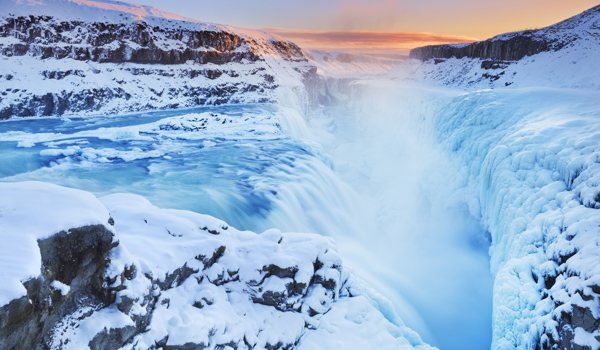
Deepest, darkest winter sees a blanket of snow cover Iceland as the Northern Lights dance against the night sky, The nights are long and the temperature dips below freezing, but there is something particularly magical about spending deep winter in Iceland. Tumbling waterfalls morph into icy cascades, the mountains boast a dusting of snow, ice caves open up on glaciers and there’s the best chance to spot the Northern Lights. Find out why you should visit during the colder months with our guide to visiting Iceland in winter.
Iceland’s 13 days of Christmas
What makes Christmas in Iceland special? While of course it has many similarities, Icelandic Christmas is a little bit different to Christmas in the rest of the world.
Those differences begin with the Christmas calendar. Rather than the 12 days of Christmas celebrated elsewhere, Icelandic Christmas has 13 days. And traditionally, that’s because of the Yule Lads.
Who are the Icelandic Yule Lads?
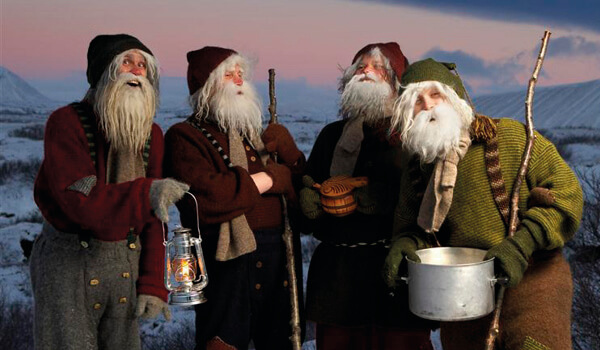
If there’s one Christmas tradition that’s exclusive to Iceland it’s the 13 Yule Lads. They arrive on the scene on the thirteenth day before Christmas Eve—11 December, roughly halfway through Advent—to cause trouble and bring gifts. Then, they depart on the 6 January (13 days after Christmas Eve), to mark the end of the Christmas season.
But who are the Yule Lads? Often described as the Icelandic equivalent to Santa Claus, the Yule Lads—or Jólasveinar in Icelandic—are 13 mischievous trolls that come down from the mountains at Christmas.
In reality, they’re not really like Santa Claus at all. In Icelandic folklore, their parents, known as Grýla and Leppalúði, live in a cave and eat naughty children. Once upon a time, the Yule Lads did the same, but now they’re much more innocent characters. These days, the Yule Lads leave gifts in the shoes of children—one every night until the night before Christmas.
However, they cause a lot of trouble at the same time. The first to arrive (on the night of 11 December) is Stekkjastaur, with a wooden leg, who bothers the sheep in Icelanders’ farms. The next day Giljagaur arrives, known for stealing the froth from cows’ milk.
One by one they come. The next night, Stúfur arrives, the shortest lad, who steals food from frying pans. Then there’s Þvörusleikir (Spoonlicker), Pottaskefill (Pot-scraper), Askasleikir (Bowl-licker), Hurðaskellir (Door-slammer), Skyrgámur (Skyr-gobbler), Bjúgnakrækir (Sausage-stealer), Gluggagægir (Window-peeker), Gáttaþefur (Door-sniffer), Ketkrókur (Meat Hook), and Kertasníkir (Candle-beggar).
And then, in the same order in which they came, they leave again, one at a time. When the last Yule Lad has departed, Christmas is over.
What is the Christmas Cat in Iceland?

Apart from generally bringing mischief to Icelanders throughout the Christmas season, the Yule Lads also have a cat who lives with them in their cave with Grýla and Leppalúði. You may see him in the streets of Reykjavik during the Christmas season.
The so-called Christmas Cat—Jólakötturinn—lurks in the Icelandic countryside throughout the Christmas period. It’s known to eat anyone who has not received a new item of clothing by Christmas Eve.
While even just a pair of socks will save you from the threat of the Christmas Cat, it’s important that you receive a gift before Christmas Eve!
• Discover more fun facts about Iceland
How is Christmas celebrated in Iceland?
Christmas is celebrated in Iceland in very similar ways to the rest of the world. However, different days in the Christmas season do have different significance. Here’s what you can expect day by day throughout the period.
Christmas traditions in Iceland
St Thorlac’s Mass (Þorláksmessa): 23 December
The final day before Christmas celebrations really kick off is known as St Thorlac’s Mass, named after the patron saint of Iceland, Thorlac Thorhallsson.
Traditionally, this is the day when Icelanders finish decorating their Christmas tree and buying or wrapping up any gifts. It’s common for people to go out to see friends and have a drink in a bar, before they settle down with family for Christmas.
Before they go out, it’s an Icelandic Christmas tradition to eat skate, a type of fish, on Þorláksmessa. Typically, it’s fermented and served with potatoes. (You can discover more about Icelandic food below!)
Christmas Eve (Aðfangadagur, or Jól Eve): 24 December
Christmas Eve, or Jól Eve, is also known as Aðfangadagur, and it’s the most important day in the Christmas calendar.
The morning is spent in making any final preparations before the celebrations kick off at 18:00. Then, we sit down for the big Christmas meal—typically of hangikjöt, smoked lamb—and give and open presents.
One of the most famous Christmas Eve traditions in Iceland is what’s known as Jólabókaflód, or “Christmas book flood”. Most people in Iceland give and receive books on Christmas Eve, which they then spend the rest of the evening reading. Other people go to mass in the evening of Christmas Eve, to meet their neighbours and friends and celebrate the religious festival.
Christmas Day (Jóladagur): 25 December
On Christmas Day, or Jóladagur, the normal tradition in Iceland is to see family, enjoy the gifts you’ve received, and eat another big meal.
Alternatively, read, watch a film, or play games. There’s no precise way to celebrate Christmas Day itself, so long as you have a nice, relaxing time.
Boxing Day (Annar í jólum): 26 December
Boxing Day passes in a very similar way to Christmas Day. In fact, it’s known in Icelandic as “the second day of Christmas”. You may see family that you hadn’t seen on the previous day, or just spend the day relaxing once more.
The one big difference is that on 26 December, Icelanders go out to party with their friends, as the bars reopen.
New Year’s Eve traditions in Iceland
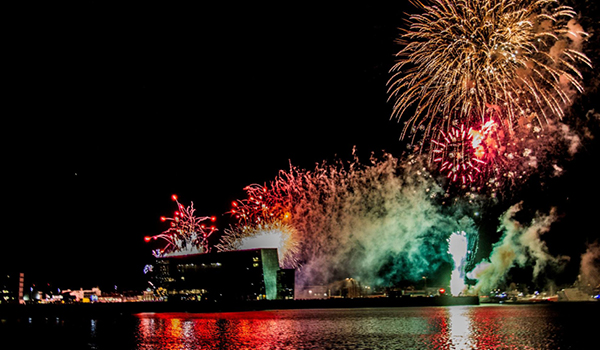
The period between Christmas and New Year passes in tranquillity in Iceland. Some people return to work for a few days and others just enjoy their time off. At the same time, the Yule Lads are leaving one by one, ticking down the time to the end of the Christmas period.
Then, at New Year, celebrations start once more.
New Year’s Eve (Gamlaársdagur): 31 December
31 December is known as Gamlaársdagur (Old Year’s Day) or Gamlárskvöld (Old Year’s Evening). This is when Iceland looks back on the year gone by. Fireworks play a major role in Iceland’s New Year’s Eve celebrations. After an evening meal, families and friends attend neighbourhood bonfires and light massive displays of fireworks. Icelanders set alight more than 600 tonnes of fireworks each year at New Year, to create an incredible spectacle against the night sky.
However, between bonfires and the biggest firework display at midnight, you’ll need to find a TV. An important New Year tradition in Iceland is to watch Áramótaskaupið, a comedy show where the events of the past year are remembered in a humorous light. You’ll be in good company: it’s watched by more than 70% of the nation every year.
Then, back to the fireworks, for one of the most impressive displays in the world. And, after that, it’s party time. In Iceland, New Year’s Eve is one of the biggest nights of the year.
New Year’s Eve in Iceland
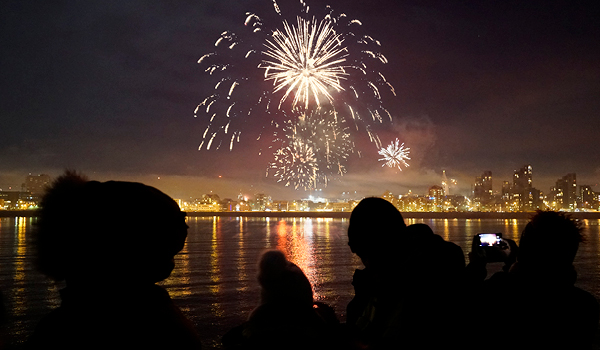
What happens at New Year in Iceland? What are the best New Yerar's Eve tours and activities? Read our detailed article about New Year's Eve in Iceland.
New Year’s Day (Nýársdagur): 1 January
If 31 December is known as Old Year’s Day, 1 January is predictably called Nýársdagur, New Year.
There are no set traditions for Nýársdagur. Typically, Icelanders nurse their hangovers and enjoy the final public holiday of the season.
The 13th Day of Christmas (Þrettándinn): 6 January
6 January is the last day of the Christmas season in many cultures, when decorations need to be put away and when you prepare to go back to work the next day. In Iceland, it’s known as the Thirteenth, when the final Yule Lad leaves for the year.
Traditionally, it would be a day when everything was used up—candles are burned, any leftovers are finished, and everyone takes their last opportunity to relax. However, it’s not all so straightforward. The Thirteenth is also a time of strange happenings in Icelandic folklore. For example, it’s a day when cows can speak, when seals become humans, and when fairies find a new home.
What do you eat in Iceland for Christmas?
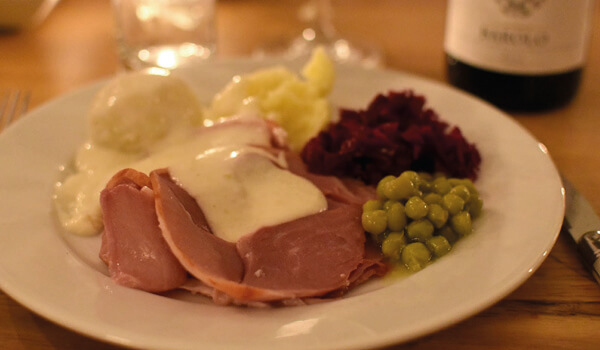
Like Icelandic food throughout the rest of the year, Christmas food in Iceland is quite particular.
Here’s just some of the Icelandic Christmas food you can enjoy:
• Hangikjöt. Probably the centrepiece of most Icelandic Christmas dinners, hangikjöt is smoked lamb—but with a twist. For example, it’s often smoked in sheep dung, then boiled and served cold. Typically, you’ll eat it served with a bechamel sauce and potatoes on Christmas Eve.
• Rjúpa. Rjúpa, or ptarmigan, is a type of grouse that lives on rocky mountainsides. In Iceland, it’s one of the most typical Christmas dishes, often boiled then fried. However, these days there’s a quota on how many ptarmigan can be caught—meaning it’s not always available.
• Skate. A fixture of St Thorlac’s Mass (23 December), skate is traditionally eaten fermented. To say its taste is particular is an understatement.
• Marinated herring. A popular dish across northern Europe, marinated or pickled herring is an Icelandic Christmas favourite.
• Laufabrauð. A thin bread (translating as “leafbread” in English) into which Icelanders cut pretty patterns, laufabrauð is typically fried and covered in sugar.
• Christmas cookies. Many families get together to bake cookies throughout the Christmas period, often with ginger or jam.
• Brennivín. Known as “the Black Death”, brennivín is the most famous Icelandic liquor, which comes out during the Christmas period. It’s made from fermented grain or potato, flavoured with caraway seeds.
• Jólaöl. Despite its name, “Christmas ale” is not actually a beer. However, that doesn’t stop it being an incredibly popular festive drink. It’s made with malt and oranges.
• Experience Iceland’s food for yourself on a food lover’s tour of Reykjavik, or join a Reykjavik beer and booze tour
Experience Christmas and New Year in Iceland
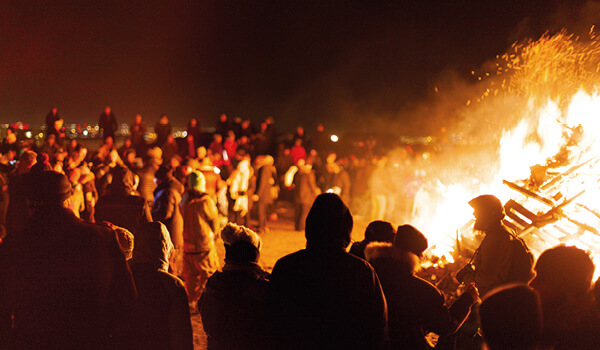
Fancy coming to experience Iceland’s Christmas traditions for yourself? At Reykjavik Excursions, we can help you experience some of the best of Icelandic Christmas.
For example, join us for a Reykjavik Christmas walk, in which we’ll show you some of the most wonderful festive displays in the city while sharing fun facts about Icelandic Christmas tradition. You can also combine the walk with a journey around Iceland’s Golden Circle too.
Alternatively, celebrate Icelandic New Year with us. You can see some of the best fireworks displays on a bonfire tour of Reykjavik, or let us take you to the town of the elves in our tour of New Year traditions.
Our New Year's Traditions and Mystery tour is a fun and immersive morning tour introduces you to the unique traditions and Icelandic folklore surrounding the magical New Year’s Eve in Iceland with stops at the Reyscue Teams firework sales, Reykjavík’s old cemetery for eerie tales, and an elf stone in Hafnarfjörður to experience the magic of hidden folk.
Celebrate New Year's Eve aboard our luxury vessel for the best views of Reykjavík's legendary fireworks display. Departing from the Old Harbour at 11 pm, the cruise offers panoramic views of the city’s lights and fireworks from Faxaflói Bay. Toast to the New Year with a complimentary glass of Champagne, then enjoy the lively Reykjavík night after your return.
While Iceland’s Christmas traditions are charming in themselves, there’s a lot more for you to do in the country over the Christmas season. Iceland is a gorgeous place throughout the winter, with snow-covered landscapes, delicate late sunsets, and dark skies.
Some of Iceland’s must-see places—from Iceland’s south coast to the Golden Circle—are at their very best in this season. Don’t miss the opportunity to visit them while you’re here.
Witness Iceland’s Christmas traditions with Reykjavik Excursions
For those who want something a little different this festive season, come and enjoy Christmas in Iceland. With mountain trolls, unique cuisine, and the delightful “Christmas book flood”, Icelandic Christmas traditions promise to make it a winter you’ll never forget.
At Reykjavik Excursions, we can show you the very best of Iceland’s Christmas seasons. With festive walks around the capital to tours to the must-see sights in Iceland, we can help you organise everything you’d want to do on your trip.
Book your Christmas in Iceland today. Explore our Christmas tours and activities to get started.
Áhugaverðar ferðir
Blogg
Fáðu innblástur! Upplýsingar og góð ráð, áhugaverðir áfangastaðir, skemmtilegar staðreyndar og margt fleira. Bloggið okkar er á ensku en það er stórskemmtilegt engu að síður!
The Silver Circle of West Iceland - Your Guide
You’ve heard of the Golden Circle, but here’s why you should head to Iceland’s western region to explore the msytical Silver Circle tour route.
Lesa bloggIcelandic Christmas Traditions: What You Need to Know
Christmas in Iceland is the most wonderful time of the year. But things might not be quite what you expect. Alongside celebrations that will be familiar to many, Iceland has its own festive traditions that sets this country apart.
1. nóvember 2024
Icelandic Christmas Traditions: What You Need to Know
Christmas in Iceland is the most wonderful time of the year. But things might not be quite what you expect. Alongside celebrations that will be familiar to many, Iceland has its own festive traditions that sets this country apart.
1. nóvember 2024
In this article, we share everything you need to know about Iceland’s Christmas traditions. You’ll meet some of the main characters from Iceland’s Christmas folk festivities and discover what we eat, drink, and get up to throughout the Christmas season.
And while you’re here, we’d like to extend an invitation to come and celebrate Christmas with us. At Reykjavik Excursions, we run many tours and activities during Christmas & New Year in Iceland. Come and join the festive fun!
Is Iceland a good place to visit at Christmas?
Iceland isn’t just a good place to visit at Christmas. It’s possibly one of the best countries in the world to visit at this time of year. Why? Because it gives you everything that’s so special about Christmas alongside the particular beauties of Icelandic winter.
Reindeer? Check. Snow-covered hills? Check. Cosy evenings by the open fire? You bet. And let’s not forget the northern lights in Iceland—one of the most entrancing spectacles on the planet.
All this adds up to make Iceland a true winter wonderland. Whether you want to come for a romantic trip for two, or you’re bringing the whole family, there’s really nothing quite like Christmas in Iceland.
But there are two important things to know about Icelandic Christmas before you visit. Firstly, in Iceland, Christmas is known as Jól—like the English word “yule”, which was the name of the Germanic winter festival before it became part of Christian tradition.
Secondly, the Christmas period lasts for 26 days, from the arrival of the first Yule Lad on the 12 December to their departure on the 6 January. It’s a particular quirk that makes Icelandic Christmas traditions particularly special. Read on to discover what Christmas in Iceland holds in store.
• Learn more about Iceland in winter or discover the best time to visit Iceland
How does Iceland celebrate Advent?
To understand how we Icelanders celebrate Christmas, let’s start from the beginning of the festive season. Like everywhere else that celebrates Christmas, that starts with Advent.
Traditionally, Advent is the period of expectation and preparation for Christmas. It's the time when you put up a Christmas tree, decorate your home, and begin Christmas traditions. It kicks off on the fourth Sunday before Christmas (which in 2022 for example is 27 November).
Like in other countries, different Icelandic families will celebrate Advent slightly differently. For example, you’ll see some Icelanders put Advent lights in their windows, which typically consist of seven candles (although these are likely electric these days). Others display Advent wreaths, with four candles each lit on one of the Sundays before Christmas.
As a visitor, you’ll notice that, during the festive season, there are Christmas lights simply everywhere, illuminating the dark Icelandic winter. These set the scene for the Christmas events that take place throughout the period.
For example, you can try a Christmas market, such as that at Ingólfstorg in Reykjavik, with its wooden huts and ice-skating rink. Or head to the Heiðmörk Nature Reserve, where you can attend a market with a live concert, children’s activities, and more.
Alternatively, attend a Christmas concert throughout the period. For example, go to see some of Iceland’s best-known performers at Jólagestir Björgvins at Reykjavik’s most iconic concert hall, Harpa.
Wherever you go, in Reykjavik or in smaller towns across the country, you’ll be able to share in our Icelandic Christmas traditions.
Winter in Iceland

Deepest, darkest winter sees a blanket of snow cover Iceland as the Northern Lights dance against the night sky, The nights are long and the temperature dips below freezing, but there is something particularly magical about spending deep winter in Iceland. Tumbling waterfalls morph into icy cascades, the mountains boast a dusting of snow, ice caves open up on glaciers and there’s the best chance to spot the Northern Lights. Find out why you should visit during the colder months with our guide to visiting Iceland in winter.
Iceland’s 13 days of Christmas
What makes Christmas in Iceland special? While of course it has many similarities, Icelandic Christmas is a little bit different to Christmas in the rest of the world.
Those differences begin with the Christmas calendar. Rather than the 12 days of Christmas celebrated elsewhere, Icelandic Christmas has 13 days. And traditionally, that’s because of the Yule Lads.
Who are the Icelandic Yule Lads?

If there’s one Christmas tradition that’s exclusive to Iceland it’s the 13 Yule Lads. They arrive on the scene on the thirteenth day before Christmas Eve—11 December, roughly halfway through Advent—to cause trouble and bring gifts. Then, they depart on the 6 January (13 days after Christmas Eve), to mark the end of the Christmas season.
But who are the Yule Lads? Often described as the Icelandic equivalent to Santa Claus, the Yule Lads—or Jólasveinar in Icelandic—are 13 mischievous trolls that come down from the mountains at Christmas.
In reality, they’re not really like Santa Claus at all. In Icelandic folklore, their parents, known as Grýla and Leppalúði, live in a cave and eat naughty children. Once upon a time, the Yule Lads did the same, but now they’re much more innocent characters. These days, the Yule Lads leave gifts in the shoes of children—one every night until the night before Christmas.
However, they cause a lot of trouble at the same time. The first to arrive (on the night of 11 December) is Stekkjastaur, with a wooden leg, who bothers the sheep in Icelanders’ farms. The next day Giljagaur arrives, known for stealing the froth from cows’ milk.
One by one they come. The next night, Stúfur arrives, the shortest lad, who steals food from frying pans. Then there’s Þvörusleikir (Spoonlicker), Pottaskefill (Pot-scraper), Askasleikir (Bowl-licker), Hurðaskellir (Door-slammer), Skyrgámur (Skyr-gobbler), Bjúgnakrækir (Sausage-stealer), Gluggagægir (Window-peeker), Gáttaþefur (Door-sniffer), Ketkrókur (Meat Hook), and Kertasníkir (Candle-beggar).
And then, in the same order in which they came, they leave again, one at a time. When the last Yule Lad has departed, Christmas is over.
What is the Christmas Cat in Iceland?

Apart from generally bringing mischief to Icelanders throughout the Christmas season, the Yule Lads also have a cat who lives with them in their cave with Grýla and Leppalúði. You may see him in the streets of Reykjavik during the Christmas season.
The so-called Christmas Cat—Jólakötturinn—lurks in the Icelandic countryside throughout the Christmas period. It’s known to eat anyone who has not received a new item of clothing by Christmas Eve.
While even just a pair of socks will save you from the threat of the Christmas Cat, it’s important that you receive a gift before Christmas Eve!
• Discover more fun facts about Iceland
How is Christmas celebrated in Iceland?
Christmas is celebrated in Iceland in very similar ways to the rest of the world. However, different days in the Christmas season do have different significance. Here’s what you can expect day by day throughout the period.
Christmas traditions in Iceland
St Thorlac’s Mass (Þorláksmessa): 23 December
The final day before Christmas celebrations really kick off is known as St Thorlac’s Mass, named after the patron saint of Iceland, Thorlac Thorhallsson.
Traditionally, this is the day when Icelanders finish decorating their Christmas tree and buying or wrapping up any gifts. It’s common for people to go out to see friends and have a drink in a bar, before they settle down with family for Christmas.
Before they go out, it’s an Icelandic Christmas tradition to eat skate, a type of fish, on Þorláksmessa. Typically, it’s fermented and served with potatoes. (You can discover more about Icelandic food below!)
Christmas Eve (Aðfangadagur, or Jól Eve): 24 December
Christmas Eve, or Jól Eve, is also known as Aðfangadagur, and it’s the most important day in the Christmas calendar.
The morning is spent in making any final preparations before the celebrations kick off at 18:00. Then, we sit down for the big Christmas meal—typically of hangikjöt, smoked lamb—and give and open presents.
One of the most famous Christmas Eve traditions in Iceland is what’s known as Jólabókaflód, or “Christmas book flood”. Most people in Iceland give and receive books on Christmas Eve, which they then spend the rest of the evening reading. Other people go to mass in the evening of Christmas Eve, to meet their neighbours and friends and celebrate the religious festival.
Christmas Day (Jóladagur): 25 December
On Christmas Day, or Jóladagur, the normal tradition in Iceland is to see family, enjoy the gifts you’ve received, and eat another big meal.
Alternatively, read, watch a film, or play games. There’s no precise way to celebrate Christmas Day itself, so long as you have a nice, relaxing time.
Boxing Day (Annar í jólum): 26 December
Boxing Day passes in a very similar way to Christmas Day. In fact, it’s known in Icelandic as “the second day of Christmas”. You may see family that you hadn’t seen on the previous day, or just spend the day relaxing once more.
The one big difference is that on 26 December, Icelanders go out to party with their friends, as the bars reopen.
New Year’s Eve traditions in Iceland

The period between Christmas and New Year passes in tranquillity in Iceland. Some people return to work for a few days and others just enjoy their time off. At the same time, the Yule Lads are leaving one by one, ticking down the time to the end of the Christmas period.
Then, at New Year, celebrations start once more.
New Year’s Eve (Gamlaársdagur): 31 December
31 December is known as Gamlaársdagur (Old Year’s Day) or Gamlárskvöld (Old Year’s Evening). This is when Iceland looks back on the year gone by. Fireworks play a major role in Iceland’s New Year’s Eve celebrations. After an evening meal, families and friends attend neighbourhood bonfires and light massive displays of fireworks. Icelanders set alight more than 600 tonnes of fireworks each year at New Year, to create an incredible spectacle against the night sky.
However, between bonfires and the biggest firework display at midnight, you’ll need to find a TV. An important New Year tradition in Iceland is to watch Áramótaskaupið, a comedy show where the events of the past year are remembered in a humorous light. You’ll be in good company: it’s watched by more than 70% of the nation every year.
Then, back to the fireworks, for one of the most impressive displays in the world. And, after that, it’s party time. In Iceland, New Year’s Eve is one of the biggest nights of the year.
New Year’s Eve in Iceland

What happens at New Year in Iceland? What are the best New Yerar's Eve tours and activities? Read our detailed article about New Year's Eve in Iceland.
New Year’s Day (Nýársdagur): 1 January
If 31 December is known as Old Year’s Day, 1 January is predictably called Nýársdagur, New Year.
There are no set traditions for Nýársdagur. Typically, Icelanders nurse their hangovers and enjoy the final public holiday of the season.
The 13th Day of Christmas (Þrettándinn): 6 January
6 January is the last day of the Christmas season in many cultures, when decorations need to be put away and when you prepare to go back to work the next day. In Iceland, it’s known as the Thirteenth, when the final Yule Lad leaves for the year.
Traditionally, it would be a day when everything was used up—candles are burned, any leftovers are finished, and everyone takes their last opportunity to relax. However, it’s not all so straightforward. The Thirteenth is also a time of strange happenings in Icelandic folklore. For example, it’s a day when cows can speak, when seals become humans, and when fairies find a new home.
What do you eat in Iceland for Christmas?

Like Icelandic food throughout the rest of the year, Christmas food in Iceland is quite particular.
Here’s just some of the Icelandic Christmas food you can enjoy:
• Hangikjöt. Probably the centrepiece of most Icelandic Christmas dinners, hangikjöt is smoked lamb—but with a twist. For example, it’s often smoked in sheep dung, then boiled and served cold. Typically, you’ll eat it served with a bechamel sauce and potatoes on Christmas Eve.
• Rjúpa. Rjúpa, or ptarmigan, is a type of grouse that lives on rocky mountainsides. In Iceland, it’s one of the most typical Christmas dishes, often boiled then fried. However, these days there’s a quota on how many ptarmigan can be caught—meaning it’s not always available.
• Skate. A fixture of St Thorlac’s Mass (23 December), skate is traditionally eaten fermented. To say its taste is particular is an understatement.
• Marinated herring. A popular dish across northern Europe, marinated or pickled herring is an Icelandic Christmas favourite.
• Laufabrauð. A thin bread (translating as “leafbread” in English) into which Icelanders cut pretty patterns, laufabrauð is typically fried and covered in sugar.
• Christmas cookies. Many families get together to bake cookies throughout the Christmas period, often with ginger or jam.
• Brennivín. Known as “the Black Death”, brennivín is the most famous Icelandic liquor, which comes out during the Christmas period. It’s made from fermented grain or potato, flavoured with caraway seeds.
• Jólaöl. Despite its name, “Christmas ale” is not actually a beer. However, that doesn’t stop it being an incredibly popular festive drink. It’s made with malt and oranges.
• Experience Iceland’s food for yourself on a food lover’s tour of Reykjavik, or join a Reykjavik beer and booze tour
Experience Christmas and New Year in Iceland

Fancy coming to experience Iceland’s Christmas traditions for yourself? At Reykjavik Excursions, we can help you experience some of the best of Icelandic Christmas.
For example, join us for a Reykjavik Christmas walk, in which we’ll show you some of the most wonderful festive displays in the city while sharing fun facts about Icelandic Christmas tradition. You can also combine the walk with a journey around Iceland’s Golden Circle too.
Alternatively, celebrate Icelandic New Year with us. You can see some of the best fireworks displays on a bonfire tour of Reykjavik, or let us take you to the town of the elves in our tour of New Year traditions.
Our New Year's Traditions and Mystery tour is a fun and immersive morning tour introduces you to the unique traditions and Icelandic folklore surrounding the magical New Year’s Eve in Iceland with stops at the Reyscue Teams firework sales, Reykjavík’s old cemetery for eerie tales, and an elf stone in Hafnarfjörður to experience the magic of hidden folk.
Celebrate New Year's Eve aboard our luxury vessel for the best views of Reykjavík's legendary fireworks display. Departing from the Old Harbour at 11 pm, the cruise offers panoramic views of the city’s lights and fireworks from Faxaflói Bay. Toast to the New Year with a complimentary glass of Champagne, then enjoy the lively Reykjavík night after your return.
While Iceland’s Christmas traditions are charming in themselves, there’s a lot more for you to do in the country over the Christmas season. Iceland is a gorgeous place throughout the winter, with snow-covered landscapes, delicate late sunsets, and dark skies.
Some of Iceland’s must-see places—from Iceland’s south coast to the Golden Circle—are at their very best in this season. Don’t miss the opportunity to visit them while you’re here.
Witness Iceland’s Christmas traditions with Reykjavik Excursions
For those who want something a little different this festive season, come and enjoy Christmas in Iceland. With mountain trolls, unique cuisine, and the delightful “Christmas book flood”, Icelandic Christmas traditions promise to make it a winter you’ll never forget.
At Reykjavik Excursions, we can show you the very best of Iceland’s Christmas seasons. With festive walks around the capital to tours to the must-see sights in Iceland, we can help you organise everything you’d want to do on your trip.
Book your Christmas in Iceland today. Explore our Christmas tours and activities to get started.
Áhugaverðar ferðir
Blogg
Fáðu innblástur! Upplýsingar og góð ráð, áhugaverðir áfangastaðir, skemmtilegar staðreyndar og margt fleira. Bloggið okkar er á ensku en það er stórskemmtilegt engu að síður!
The Silver Circle of West Iceland - Your Guide
You’ve heard of the Golden Circle, but here’s why you should head to Iceland’s western region to explore the msytical Silver Circle tour route.
Lesa blogg